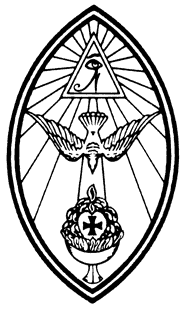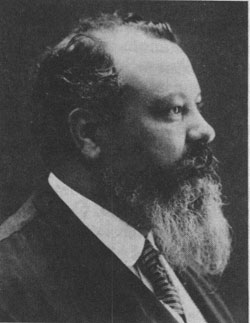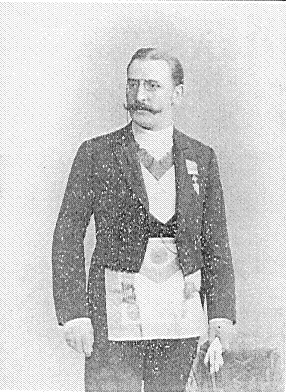A magical organization or magical order is an organization or secret society created for the practice of initiation into ceremonial or other forms of occult magic or to further the knowledge of magic among its members. Magical organizations can include Hermetic orders, esoteric societies, arcane colleges, and other groups which may use different terminology and similar though diverse practices.

Thelema is a Western esoteric and occult social or spiritual philosophy, as well as a new religious movement that was founded in the early 1900s by Aleister Crowley (1875–1947), an English writer, mystic, occultist, and ceremonial magician. Central to Thelema is the idea of discovering and following one's True Will, a unique purpose and calling that goes beyond ordinary desires. Crowley's system begins with The Book of the Law, a text he said was dictated to him by an entity named Aiwass. This foundational work lays out key principles, including the central axiom "Do what thou wilt shall be the whole of the Law". This principle emphasizes personal freedom and the pursuit of one's true path, while being guided by love and finding one's authentic purpose.

Ordo Templi Orientis is an occult secret society and hermetic magical organization founded at the beginning of the 20th century. The origins of O.T.O. can be traced back to the German-speaking occultists Carl Kellner, Theodor Reuss, Heinrich Klein, and Franz Hartmann. In its first incarnation, O.T.O. was intended to be modelled after and associated with European Freemasonry and as such in its early years only Freemasons could seek admittance.
Ecclesia Gnostica is an open sacramental neo-Gnostic church based in the United States. It has ordained clergy and conducts regular sacramental services, including two weekly Masses, as well as monthly and seasonal services in accordance with the liturgical calendar. It has active parishes in Seattle, Portland, Austin, and Los Angeles.
The Typhonian Order, previously known as Typhonian Ordo Templi Orientis (T.O.T.O.), is a self-initiatory magical organization based in the United Kingdom that focuses on magical and Typhonian concepts. It was originally led by British occultist Kenneth Grant (1924–2011) and his wife Steffi Grant, and is now led by their deputy Michael Staley.

Grady Louis McMurtry was an American ceremonial magician, student of occult writer Aleister Crowley, and an adherent of Thelema. He is best known for reviving the fraternal organization Ordo Templi Orientis, which he headed from 1971 until his death in 1985.

Gérard Anaclet Vincent Encausse, whose esoteric pseudonyms were Papus and Tau Vincent, was a French physician, hypnotist, and popularizer of occultism, who founded the modern Martinist Order.
Aleister Crowley wrote The Gnostic Mass — technically called Liber XV or "Book 15" — in 1913 while travelling in Moscow, Russia. The structure is similar to the Mass of the Eastern Orthodox Church and Roman Catholic Church, communicating the principles of Crowley's Thelema. It is the central rite of Ordo Templi Orientis and its ecclesiastical arm, Ecclesia Gnostica Catholica.
Sex magic is any type of sexual activity used in magical, ritualistic or otherwise religious and spiritual pursuits. One practice of sex magic is using sexual arousal or orgasm with visualization of a desired result. A premise posited by sex magicians is the concept that sexual energy is a potent force that can be harnessed to transcend one's normally perceived reality.
William Breeze, also known by his neo-Gnostic bishop title of Tau Silenus, is an American writer and publisher on magick and philosophy. He is the Sovereign Patriarch, or supreme governing cleric, of Ecclesia Gnostica Catholica (E.G.C.), the liturgical arm of Ordo Templi Orientis (O.T.O.), of which he is the current Outer Head of the Order (OHO), also known as Frater Superior, as well as caliph, the order's international leader. In this capacity he is a leading editor of the occult works of Aleister Crowley, the founder of the philosophy and religion of Thelema, who is regarded as its prophet.

Albert Karl Theodor Reuss also known by his neo-Gnostic bishop title of Carolus Albertus Theodorus Peregrinus was a German tantric occultist, freemason, journalist, singer and head of Ordo Templi Orientis.

Lon Milo DuQuette, also known as Rabbi Lamed Ben Clifford and by his neo-Gnostic bishop title of Tau Lamed, is an American writer, lecturer, musician, and occultist, best known as an author who applies humor in the field of Western Hermeticism.
Gnosticism in modern times includes a variety of contemporary religious movements, stemming from Gnostic ideas and systems from ancient Roman society. Gnosticism is an ancient name for a variety of religious ideas and systems, originating in Jewish-Christian milieux in the first and second century CE.

Babalon is a goddess found in the occult system of Thelema, which was established in 1904 with the writing of The Book of the Law by English author and occultist Aleister Crowley. The spelling of the name as "Babalon" was revealed to Crowley in The Vision and the Voice. Her name and imagery feature prominently in Crowley's "Liber Cheth vel Vallum Abiegni".
A Gnostic Mass is a liturgical Mass administered by a Gnostic church. There are several such churches, each with its own version of the Mass. Some of them are:
Marcelo Ramos Motta was a Brazilian writer, Thelemite, and member of the A∴A∴ occult society. Known for his work in the field of Thelema, he was a prominent figure in the Thelemic community and contributed significantly to its literature. Motta was also recognized by his magical names Parzival X° and Parzival XI°. His writings, which include translations of Aleister Crowley's works and original Thelemic texts, have had a lasting impact on the study and practice of Thelema in Brazil and beyond.

The Neo-Luciferian Church is a Gnostic Luciferian organisation with roots in Western esotericism, Thelema, and magic.
Many cultures practice or have practiced initiation rites, including the ancient Greeks, the Hebraic/Jewish, the Babylonian, the Mayan, and the Norse cultures. The modern Japanese practice of Miyamairi is such a ceremony. In some, such evidence may be archaeological and descriptive in nature, rather than a modern practice.

James Wasserman was an American writer and occultist. A member of Ordo Templi Orientis since 1976 and a book designer by trade, he wrote extensively on spiritual and political liberty.

The Gnostic Church of France is a neo-Gnostic Christian organisation formed by Jules Doinel in 1890, in France. It is the first Gnostic church in modern times.









